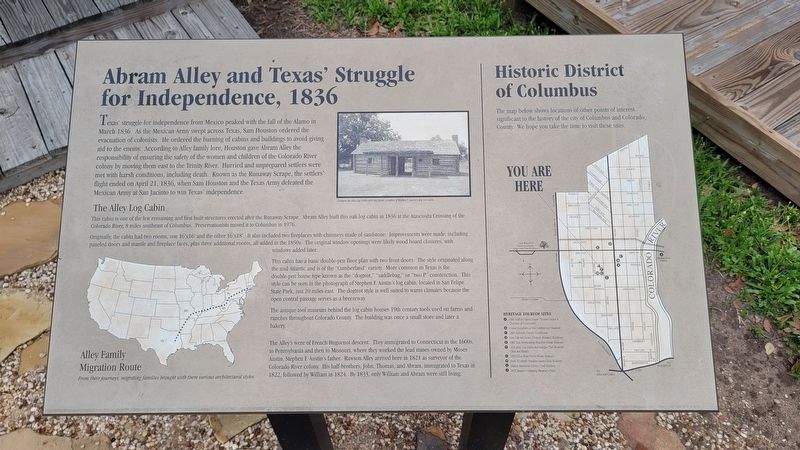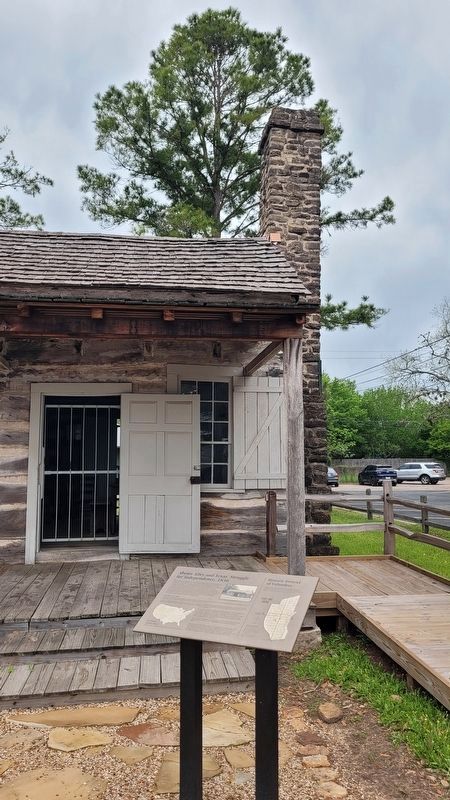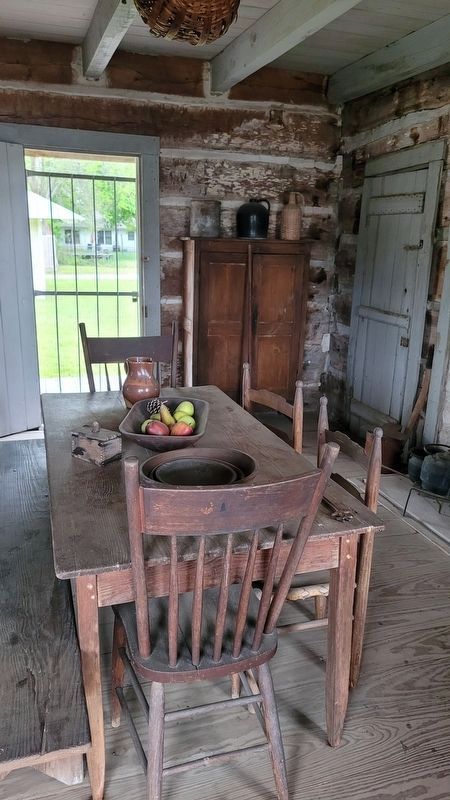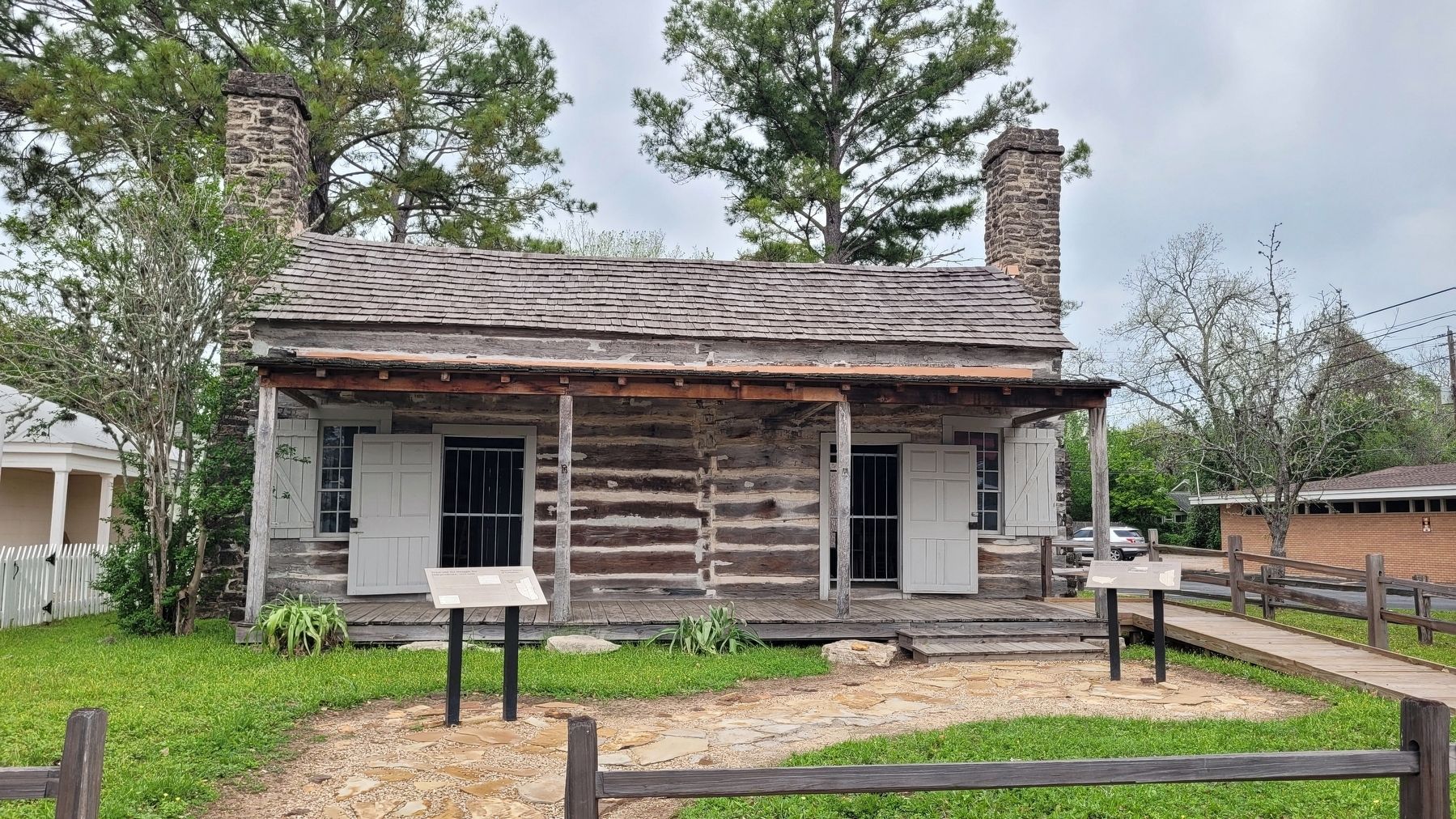Columbus in Colorado County, Texas — The American South (West South Central)
Abram Alley and Texas' Struggle for Independence
1836
Inscription.
Texas struggle for independence from Mexico peaked with the fall of the Alamo in March 1836. As the Mexican Army swept across Texas, Sam Houston ordered the evacuation of colonists. He ordered the burning of cabins and buildings to avoid giving aid to the enemy. According to Alley family lore, Houston gave Abram Alley the responsibility of ensuring the safety of the women and children of the Colorado River colony by moving them east to the Trinity River. Hurried and unprepared settlers were met with harsh conditions, including death. Known as the Runaway Scrape, the settlers' flight ended on April 21, 1836, when Sam Houston and the Texas Army defeated the Mexican Army at San Jacinto to win Texas' independence.
The Alley Log Cabin
This cabin is one of the few remaining and first built structures erected after the Runaway Scrape. Abram Alley built this oak log cabin in 1836 at the Atascosita Crossing of the Colorado River, 8 miles southeast of Columbus. Preservationists moved it to Columbus in 1976.
Originally, the cabin had two rooms, one 16'x16 and the other 16'x18'. It also included two fireplaces with chimneys made of sandstone. Improvements were made, including paneled doors and mantle and fireplace faces, plus three additional rooms, all added in the 1850s. The original window openings were likely wood board closures, with windows added later.
This cabin has a basic double-pen floor plan with two front doors. The style originated along the mid-Atlantic and is of the "Cumberland" variety. More common in Texas is the double-pen house type known as the "dogtrot," "saddlebag," or "two P" construction. This style can be seen in the photograph of Stephen F. Austin's log cabin, located in San Felipe State Park, just 20 miles east. The dogtrot style is well suited to warm climates because the open central passage serves as a breezeway.
The antique tool museum behind the log cabin houses 19th century tools used on farms and ranches throughout Colorado County. The building was once a small store and later a bakery.
The Alley's were of French Huguenot descent. They immigrated to Connecticut in the 1600s, to Pennsylvania and then to Missouri, where they worked the lead mines owned by Moses Austin, Stephen F. Austin's father. Rawson Alley arrived here in 1821 as surveyor of the Colorado River colony. His half-brothers, John, Thomas, and Abram, immigrated to Texas in 1822, followed by William in 1824. By 1833, only William and Abram were still living.
Captions
Alley Family Migration Route - From their journeys, migrating families brought with them various architectural styles.
Compare the Alley Log Cabin with this
photo, a replica of Stephen F. Austin's dog-trot cabin.
Topics. This historical marker is listed in these topic lists: Settlements & Settlers • War, Texas Independence. A significant historical month for this entry is March 1836.
Location. 29° 42.279′ N, 96° 32.517′ W. Marker is in Columbus, Texas, in Colorado County. Marker is on Bowie Street north of Washington Street, on the left when traveling north. The marker is located in front of the Abram Alley Log Cabin. Touch for map. Marker is in this post office area: Columbus TX 78934, United States of America. Touch for directions.
Other nearby markers. At least 8 other markers are within walking distance of this marker. Texas and the Struggle for Independence (here, next to this marker); Abram Alley Log Cabin (here, next to this marker); Dilue Rose and Ira Albert Harris House (within shouting distance of this marker); Dilue Rose Harris (1825-1914) (within shouting distance of this marker); Dilue Rose Harris (within shouting distance of this marker); William B. DeWees (within shouting distance of this marker); Fiftieth Anniversary Celebration of the American Declaration of Independence (within shouting distance of this marker); City of Columbus (about 300 feet away, measured in a direct line). Touch for a list and map of all markers in Columbus.
Also see . . . Alley, Abraham (1803–1862). Texas State Historical Association (TSHA) (Submitted on April 2, 2024, by James Hulse of Medina, Texas.)
Credits. This page was last revised on April 2, 2024. It was originally submitted on April 1, 2024, by James Hulse of Medina, Texas. This page has been viewed 39 times since then. Photos: 1, 2, 3, 4. submitted on April 2, 2024, by James Hulse of Medina, Texas.



